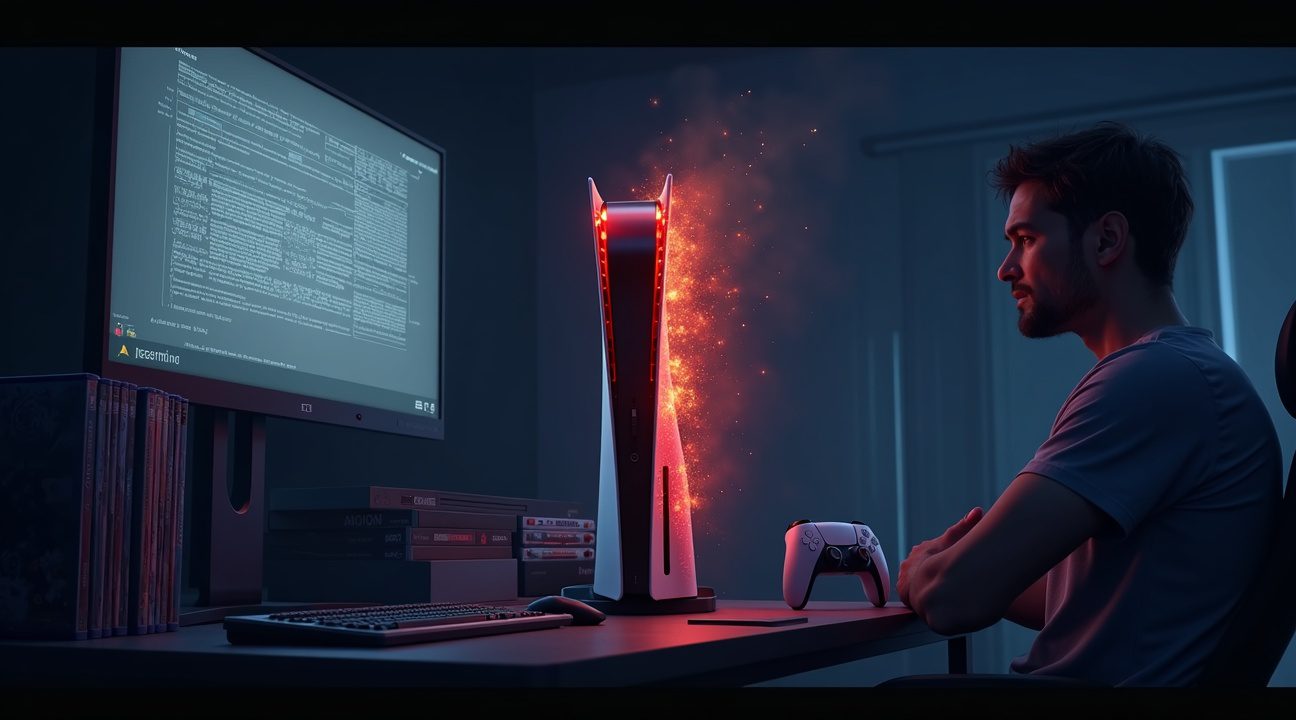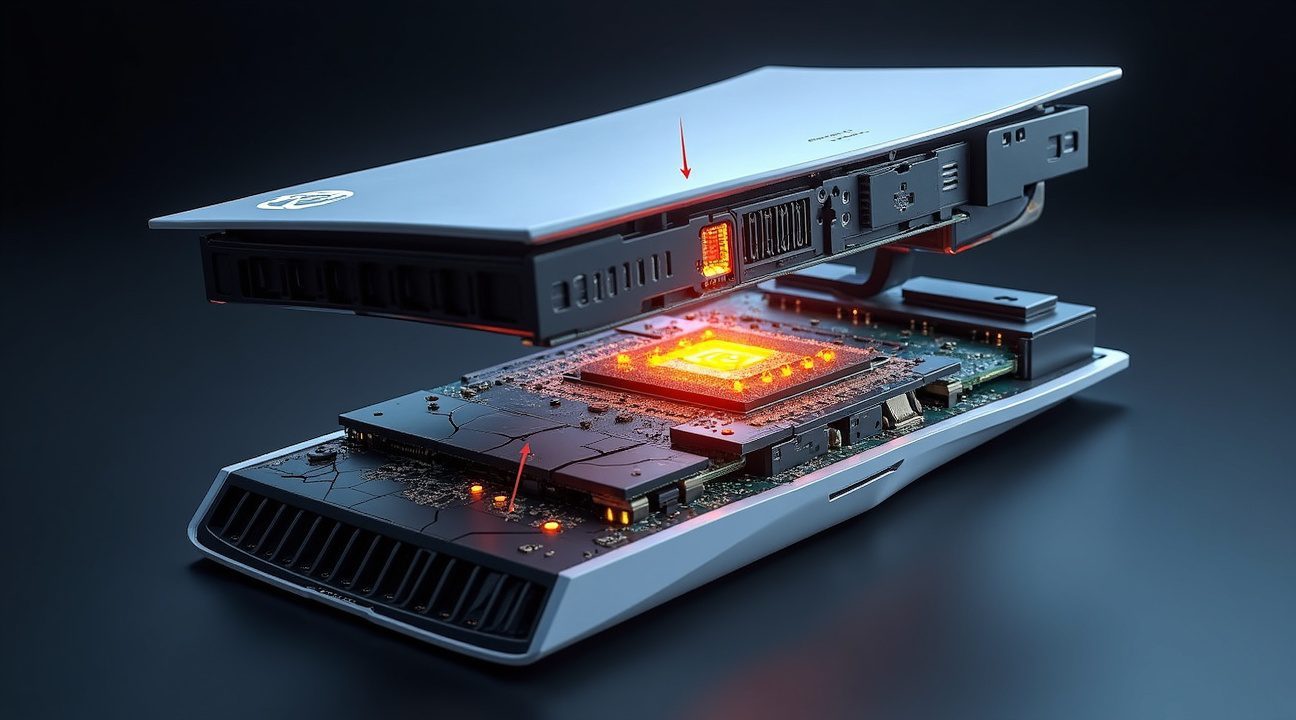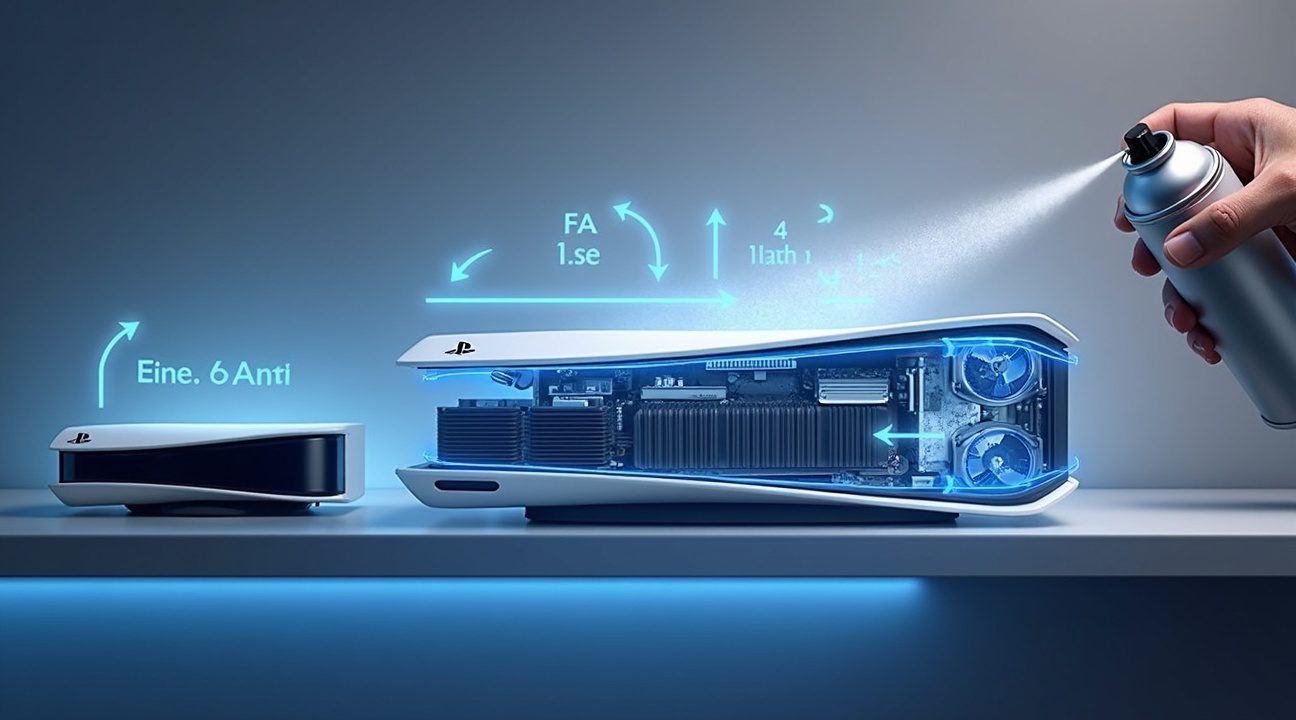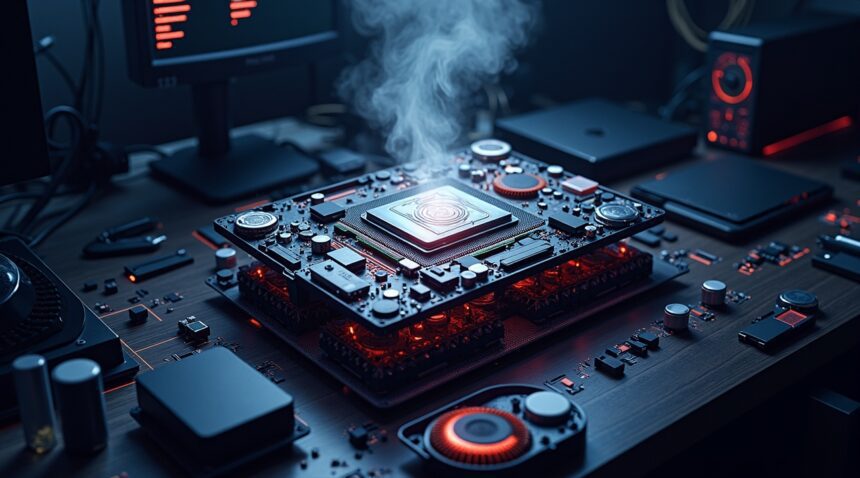PS5 owners are encountering a serious hardware problem as the liquid metal coolant, designed to manage the PlayStation 5’s thermals, leaks from its intended placement and threatens the console’s overall performance and longevity.
Key Takeaways
- Launch PS5 consoles from 2020 exhibit significantly higher risks of liquid metal leaks compared to models produced after design and manufacturing refinements. The issue is exacerbated when users position consoles vertically or move them frequently.
- Liquid metal migration away from the CPU can cause critical thermal management issues. These include unexpected shutdowns during intensive gaming, abnormal overheating, and eventual irreversible hardware failure.
- Escaped coolant may seep onto the motherboard, leading to short circuits and severe damage to internal components. In many instances, this renders the system unrepairable.
- Professional repair services offer the best chance of salvaging consoles affected by leaks. Alternatives like replacing the liquid metal with standard thermal paste are available, but users should note that this reduces cooling effectiveness considerably.
- Preventive steps such as storing the console in a horizontal position, maintaining good airflow, and cleaning dust regularly can help mitigate risks—though these measures do not eliminate the fundamental hardware flaw found in early PS5 models.
For more details on the PS5’s liquid metal design and repair insights, you can refer to [specialist articles and teardown videos](https://www.ifixit.com/News/55640/ps5-liquid-metal-leak-issue) released by iFixit.
Why Your PS5 May Be Shutting Down During Intense Gaming Sessions
Recognizing the Warning Signs
Several telltale indicators suggest your PS5 might be experiencing coolant-related thermal failures. Sudden shutdowns during intense gaming represent the most common symptom, particularly when playing graphically demanding titles that push the console’s hardware to its limits. Unexplained overheating occurs when the system becomes excessively hot even during lighter gaming sessions that previously ran without issues.
Intermittent failures create another concerning pattern where the console works perfectly for some games but consistently crashes during others. Most alarming is visible residue near the heatsink or processor region, which may indicate liquid metal coolant has begun to leak or migrate from its intended position. These signs often develop gradually, making them easy to dismiss initially as random technical glitches.
The Growing Problem and Diagnostic Challenges
Following an update to the game Path of Titans, player reports of PS5 shutdowns attributed to liquid metal issues increased by approximately 2–3%. This spike highlights how specific software demanding higher thermal loads can expose underlying cooling system vulnerabilities that might otherwise remain hidden.
Unfortunately, Sony hasn’t provided built-in temperature monitoring accessible to consumers, making it nearly impossible to track thermal performance without specialized equipment. The console’s internal diagnostics don’t display temperature readings through the user interface, leaving players guessing whether their shutdowns stem from overheating or other hardware failures.
Diagnosis often requires opening the system to inspect the cooling components directly, but this approach carries significant risks. Dismantling your PS5 will void the manufacturer’s warranty, potentially leaving you financially responsible for expensive repairs that Sony would otherwise cover. Professional repair services can perform these inspections while maintaining warranty protection, though they typically charge diagnostic fees even if no repairs are needed.
Temperature-related shutdowns tend to worsen over time as thermal paste degrades and liquid metal coolant continues migrating away from critical components. Games with sustained high frame rates or intensive ray tracing features typically trigger these failures first, since they generate the most heat within the system’s processing units.
Sony’s recent price adjustments make replacement costs particularly concerning for affected users. Players experiencing consistent shutdowns during demanding titles should document the specific games and circumstances triggering these failures before pursuing repair options.
The absence of user-accessible thermal monitoring tools forces most players to rely on behavioral observations rather than concrete data when assessing their console’s cooling performance. Professional diagnostic services remain the safest path forward for users experiencing these symptoms, despite the additional expense involved in proper evaluation.
Launch PS5 Consoles Face Higher Risk of Catastrophic Failure Within Two Years
Industry experts raise serious concerns about the longevity of launch PS5 units, with engineers warning that many early consoles could experience critical failures within two years of regular use. Matthew Cassells of Alderon Games stands among the most vocal engineers highlighting this potential hardware crisis, emphasizing that heavy gaming sessions and upright console positioning significantly increase the risk of catastrophic failure.
Launch Models Show Dramatically Higher Failure Rates
Launch PS5 consoles from 2020 and early production runs demonstrate substantially higher failure risks compared to their newer counterparts. These early models contain hardware designs that make them particularly vulnerable to coolant-related failures during extended gaming sessions. The problem affects units that see regular use, especially those positioned vertically as Sony originally marketed.
Reports from the gaming community confirm that launch edition consoles experience these issues at alarming rates. Sony’s pricing strategy changes haven’t addressed these underlying hardware concerns, leaving early adopters with potentially defective units.
Newer Revisions Offer Limited Improvements
Hardware revisions in the PS5 Slim and PS5 Pro include modifications designed to reduce coolant leak risks. However, these changes don’t completely eliminate the possibility of hardware failures. Sony’s engineering team implemented these revisions after recognizing the severity of the coolant system problems affecting earlier models.
The PS5 Pro incorporates additional safeguards, but engineers stress that no current PS5 model is entirely immune to these issues. Users who purchased launch consoles face the highest risk, while those with newer revisions enjoy somewhat improved reliability.
Despite widespread reports and engineer warnings, Sony hasn’t established any formal repair program or recall initiative as of mid-2025. This absence of official recognition leaves affected users without manufacturer-backed solutions for their potentially failing consoles. The company’s silence on the matter contrasts sharply with the vocal concerns expressed by industry professionals who understand the technical implications of coolant system failures.
Users with launch PS5 units should monitor their consoles closely for signs of:
- Overheating
- Unusual fan noise
- Performance degradation
These symptoms often precede complete system failure, giving owners a narrow window to back up save data and prepare for potential hardware replacement. Sony’s continued focus on PS4 support suggests the company recognizes ongoing issues with its current-generation hardware.

How Vertical Placement and Failed Seals Cause Liquid Metal Migration
The PlayStation 5’s cooling system relies on liquid metal as a thermal interface material between the processor (APU) and heatsink to achieve optimal heat transfer. This specialized material offers superior cooling efficiency compared to traditional thermal paste, but its liquid nature creates unique challenges that can lead to serious hardware issues.
Understanding Liquid Metal Movement in Vertical Configurations
When a PS5 remains in a vertical position for extended periods, gravity becomes the enemy of proper cooling system function. The liquid metal gradually migrates away from its intended contact points, pooling in areas where it can’t effectively transfer heat. This migration process occurs slowly but persistently, reducing cooling performance over time and potentially causing permanent damage to internal components.
Physical shock amplifies this problem dramatically. Dropping the console or subjecting it to sudden movements while positioned vertically can cause rapid liquid metal displacement. The material flows toward the lowest point within the system, abandoning critical areas where heat transfer must occur. This creates hot spots on the APU that can lead to thermal throttling, system instability, and eventual hardware failure.
The containment system depends entirely on foam seals that surround the liquid metal application area. These seals act as barriers, preventing the thermal material from escaping its designated zone between the processor and heatsink. However, foam materials naturally degrade over time, especially when exposed to heat cycles that occur during normal gaming sessions.
Seal failure happens gradually through repeated heating and cooling cycles that cause the foam to lose its elasticity and create gaps. Temperature fluctuations make the foam expand and contract, eventually causing it to crack or separate from the mounting surfaces. Once these barriers fail, liquid metal finds escape routes that allow it to flow freely throughout the console’s interior.
The combination of vertical placement and compromised seals creates a perfect storm for liquid metal migration. Gravity pulls the escaped material downward while failed containment systems provide no resistance to this movement. Users often discover this issue only after experiencing performance problems or complete system failure, as the migration process occurs invisibly within the sealed console.
Manufacturing tolerances also play a role in seal effectiveness. Slight variations in foam compression or mounting pressure during assembly can create immediate vulnerabilities that worsen over time. Some units may ship with seals that appear functional but lack the proper compression needed for long-term containment.
Environmental factors accelerate seal degradation in vertical configurations. Heat accumulation in the upper portions of a vertically-placed console subjects seals to higher temperatures than horizontal placement would create. This thermal stress compounds the natural aging process of foam materials, leading to premature failure.
The migration pattern typically follows predictable paths within the console’s internal structure. Liquid metal flows from the APU area toward cable connectors, circuit boards, and other sensitive components where it can cause short circuits or permanent damage. Sony’s approach to thermal management in newer production runs has addressed some of these concerns, but existing units remain vulnerable.
Prevention requires understanding how placement affects long-term reliability:
- Horizontal positioning eliminates gravity-driven migration while reducing thermal stress on containment seals.
- Regular position changes can help redistribute liquid metal back to its intended location, though this approach carries risks if seals have already failed.
Professional repair services report that liquid metal leaks often correlate with specific usage patterns. Consoles used primarily in vertical orientation show higher failure rates, particularly among units that experience frequent transport or physical movement. The PS5 Slim design incorporates improvements to address these thermal management challenges, though the fundamental physics of liquid metal behavior remain unchanged.
Users experiencing performance degradation, unusual fan noise, or thermal shutdowns should consider professional inspection before permanent damage occurs. Early detection of liquid metal migration allows for successful remediation, while advanced cases often require complete component replacement.
https://www.youtube.com/watch?v=kiWuu-pUJmg

The Devastating Effects When Liquid Metal Escapes Its Container
When liquid metal coolant breaks free from its intended containment around the APU, the consequences can range from minor performance issues to catastrophic system failure. The cooling compound that Sony engineered to keep processors running at optimal temperatures becomes a destructive agent once it migrates beyond its designated boundaries.
Performance Degradation and Thermal Failures
Leaked coolant creates dry spots on the APU where thermal transfer becomes severely compromised. These areas can’t dissipate heat effectively, forcing the processor to work harder while fighting against rising temperatures. Overheating becomes inevitable as the cooling system loses its primary advantage over traditional thermal paste.
Random shutdowns follow as the console’s built-in safety mechanisms trigger to prevent permanent damage. The system detects dangerous temperature spikes and forces itself into emergency shutdown mode, leaving players frustrated with interrupted gaming sessions. These protective measures, while necessary, signal deeper problems within the cooling architecture.
Catastrophic System Damage
The most severe scenarios occur when liquid metal reaches the motherboard itself. Short circuits become a real threat as the conductive compound bridges connections that should remain isolated. Even minimal amounts of escaped coolant can create pathways for electrical current where none should exist.
Component damage escalates quickly once liquid metal contacts sensitive circuitry. Power regulation modules, capacitors, and other critical components face destruction from unexpected electrical paths. Complete console failure represents the worst-case outcome, rendering expensive hardware into worthless electronic waste.
Players who experience these failures often find themselves facing repair costs that approach or exceed the original purchase price. Sony’s price increases make replacement consoles even more expensive, adding financial pressure to an already frustrating situation.
The prevalence of liquid metal leakage issues remains significantly lower than historic console failures. This problem doesn’t approach the widespread nature of the Xbox 360’s “Red Ring of Death,” which affected millions of units worldwide. However, the severity of individual failures can be more devastating due to the irreversible nature of liquid metal damage.
Early adopters and heavy users face higher risks due to extended exposure to thermal cycling. Dedicated players who push their systems through long gaming sessions or intensive applications create more opportunities for coolant displacement. Newer PS5 models may incorporate design improvements to address these concerns, though Sony hasn’t officially acknowledged the cooling system modifications.
Temperature fluctuations during shipping and storage can contribute to initial coolant displacement before users even power on their consoles. Manufacturing variations in thermal compound application also create inconsistencies that some units handle better than others. Quality control challenges during the initial production rush may have allowed some problematic units to reach consumers.
The long-term implications extend beyond immediate failures, as partially leaked coolant continues degrading cooling performance over months or years. Systems that initially function normally may develop thermal issues as remaining coolant gradually migrates or dries out. Regular monitoring of system temperatures and fan behavior can help identify developing problems before complete failure occurs.
Professional repair services often struggle with liquid metal contamination because traditional cleaning methods can spread the compound further across sensitive components. Sony’s continued PS4 support provides an alternative gaming platform for users whose PS5 systems fail beyond economical repair, though this solution requires maintaining older hardware and missing next-generation gaming experiences.
Prevention Tips and Final Thoughts
Prevention remains limited for consumers since the cooling system sits beyond user-accessible areas. Here are a few practices that may help minimize risks:
- Avoid using the console in areas with extreme ambient temperatures.
- Reduce frequent movement or vibrations during operation.
- Keep the console well-ventilated for optimal air circulation.
- Monitor system performance and listen for abnormal fan noise or heat output.
Understanding these risks helps players make informed decisions about warranty coverage and backup gaming options while enjoying their PS5 systems.
Professional Repair Options and Why Thermal Paste Isn’t the Answer
When liquid metal coolant begins leaking inside a PlayStation 5, professional repair services offer the most reliable solution for restoring proper thermal management. Specialized shops like VideoGame911 and TronicsFix provide comprehensive services that address both immediate damage and prevent future leaks. Their repair process typically involves carefully cleaning all leaked liquid metal residue from affected components, applying fresh coolant material, and replacing or repairing damaged seals that allowed the initial leak to occur.
Professional Cleaning and Component Replacement
Professional repair centers possess the tools and expertise necessary to safely handle liquid metal contamination. The cleaning process requires specific solvents and techniques to remove conductive residue that could cause short circuits if left untreated. Repair technicians also replace damaged gaskets and seals that failed to contain the coolant within its designated area.
Beyond cleaning, these shops can replace or repair components that suffered damage from liquid metal contact. Circuit boards, connectors, and other sensitive electronics may require attention depending on how far the coolant spread before detection. This comprehensive approach ensures the console returns to optimal performance rather than simply addressing surface-level symptoms.
Why Thermal Paste Alternatives Fall Short
Despite its apparent simplicity, replacing liquid metal with traditional thermal paste creates more problems than it solves. Testing data consistently shows that thermal paste substitution results in significantly worse cooling performance compared to properly applied liquid metal. The performance gap becomes particularly noticeable during intensive gaming sessions or when running demanding titles that push the system’s processing capabilities.
Some users consider thermal paste replacement because they fear future liquid metal leaks, but this approach sacrifices the PS5’s designed thermal efficiency. Sony specifically chose liquid metal for its superior heat transfer properties, which traditional thermal compounds cannot match. Users who opt for thermal paste often experience higher operating temperatures, increased fan noise, and potential thermal throttling during peak performance periods.
Sony’s Design Evolution and Limited Official Response
Sony has acknowledged coolant containment issues through internal design modifications in later PlayStation 5 production runs. The company added ridges and grooves to the heatsink assembly that help keep liquid metal in its intended position during console operation and movement. These design revisions represent a practical solution for preventing leaks in newer units.
However, Sony hasn’t introduced a widespread official recall or repair program for early affected units. This absence of formal acknowledgment leaves owners of problematic consoles to seek third-party repair solutions or attempt fixes themselves. The company’s approach suggests they view the issue as affecting a limited number of units rather than representing a systemic design flaw requiring mass intervention.
Early adopters who purchased launch-window consoles may find themselves dealing with coolant leak issues more frequently than users who bought later production models. The timing of someone’s purchase can significantly impact their likelihood of encountering thermal management problems, making purchase timing an unexpected factor in long-term console reliability.
Professional repair remains the most effective path forward for affected users. While PlayStation 5 pricing considerations might make repair costs seem significant, proper professional service typically costs less than console replacement and preserves the system’s original performance characteristics. Attempting DIY fixes or accepting thermal paste substitutions often leads to ongoing problems that professional intervention could have prevented.
The liquid metal cooling system represents advanced thermal management technology that requires specialized handling. Users experiencing coolant leak symptoms should consult experienced repair professionals rather than experimenting with alternative solutions that compromise the console’s engineered performance capabilities.
Simple Steps to Minimize Your PS5’s Risk of Liquid Metal Problems
I can share several practical maintenance approaches that may help reduce the likelihood of coolant migration issues, though they don’t eliminate the design vulnerability entirely. These strategies focus on working with your console’s thermal management system rather than against it.
Essential Maintenance Practices for Thermal Protection
Regular dust cleaning stands as the most important maintenance task for your PS5. When dust accumulates on fans and heatsinks, it forces the cooling system to work harder, creating higher temperatures that can affect the thermal interface material. I recommend cleaning every 3-4 months using compressed air to clear dust from intake vents and exhaust ports. This helps maintain optimal operating temperatures and reduces thermal stress on internal components.
Horizontal placement offers another layer of protection against liquid metal migration. While Sony designed the PS5 to function in both orientations, gravity naturally works against coolant movement when the console sits flat. The PS5 Slim model maintains this same principle, making horizontal positioning a consistent recommendation across PlayStation versions.
Additional maintenance steps include:
- Ensuring adequate ventilation around your console
- Avoiding enclosed spaces that trap heat
- Keeping at least six inches of clearance on all sides
- Regularly checking that intake vents remain unobstructed
Temperature spikes put extra strain on the cooling system and thermal interface materials, so maintaining airflow is critical.
These preventive measures work best when implemented together rather than individually:
- Clean consoles run cooler
- Horizontal placement reduces gravitational effects on liquid metal
- Proper ventilation supports overall thermal management
However, these steps cannot address the fundamental design characteristics found in launch model PS5 units.
Understanding that PlayStation 5 pricing remains significant makes these maintenance practices even more valuable for protecting your investment. While newer manufacturing revisions may incorporate improvements, launch units benefit most from consistent care and optimal positioning.
Regular monitoring of your console’s fan noise can also indicate when cleaning becomes necessary. Louder fan operation often signals increased thermal load from dust buildup. Early intervention through cleaning prevents the cooling system from working in overdrive conditions that stress thermal components.
These maintenance approaches represent practical steps within user control, though they complement rather than replace proper thermal design. I view them as risk reduction measures that support your console’s longevity while acknowledging that PlayStation hardware evolution continues addressing thermal challenges across generations.

Sources:
TronicsFix: “All About PS5 Liquid Metal”
VideoGame911: “PS5 Liquid Metal Damage Symptoms and Repair Solutions”
Guru3D: “PS5 Shutdowns Linked to Liquid Metal Cooling Material Leak”
PlayStationLifestyle: “Launch PS5s Overheating Due to Design Flaw, Says Dev”
The Outerhaven: “Alderon Games Founder Warns Many PS5 Consoles Could Fail in Two Years Due to Liquid Metal Cooling Issue”
HowFixit (YouTube): “PS5 Slim Overheating Fix: Disassembly, Cleaning, Liquid Metal Replacement Guide”


